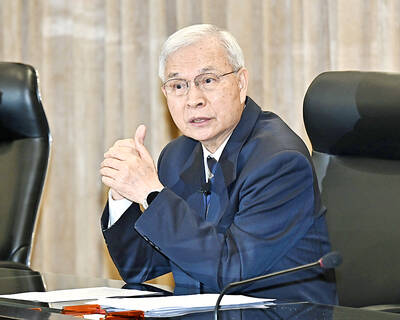Taiwan Semiconductor Manufacturing Co (TSMC, 台積電) has achieved early production yields at its first plant in Arizona that surpass similar factories back home, a significant breakthrough for a US expansion project initially dogged by delays and worker strife.
The share of chips manufactured at TSMC’s facility in Phoenix that are usable is about 4 percentage points higher than comparable facilities in Taiwan, Rick Cassidy, president of TSMC’s US division, told listeners on a webinar on Wednesday, according to a person who participated.
The success rate, or yield, is a critical measure in the semiconductor industry because it determines whether companies would be able to cover the enormous costs of a chip plant.

Photo: Bloomberg
The accomplishment is a sign of progress for Washington’s efforts to revitalize semiconductor manufacturing in the US.
TSMC, the main chip manufacturing partner for Nvidia Corp and Apple Inc, is in line to win US$6.6 billion in US government grants and US$5 billion in loans — plus 25 percent tax credits — to build three fabs in Arizona. The award, like almost all others from the 2022 CHIPS and Science Act, is not yet finalized.
The two other chipmakers at the heart of the tech strategy of US President Joe Biden’s administration — Intel Corp and Samsung Electronics Co — have struggled in the past few months.
Intel, slated to be the biggest beneficiary of the CHIPS Act, is under such severe financial pressure that it is delaying global projects and considering selling assets.
Meanwhile, TSMC has been on a roll.
Its shares reached a record high this month after the chipmaker topped quarterly estimates and raised its target for revenue growth this year.
The latest yield advancement is notable for TSMC, because it has historically kept the most advanced and efficient plants in Taiwan.
Its Arizona site got off to a rocky start, as the company could not find enough skilled staff to install advanced equipment, and workers struggled with safety and management issues.
TSMC reached an accord with construction labor unions late last year.
The chipmaker originally planned to have its first Arizona plant start full production this year, but pushed back the target to next year over the labor issues. It later delayed the start date for its second fab to 2027 or 2028, from an initial target of 2026. That fueled concerns that the company might not be able to make chips in the US as efficiently as in Taiwan.
TSMC could now be keen to expand its US presence further, depending in part on the possibility of more US government backing, Cassidy said, citing early conversations in Washington about a second CHIPS Act.
There is room for at least six fabs at the Phoenix complex.

The CIA has a message for Chinese government officials worried about their place in Chinese President Xi Jinping’s (習近平) government: Come work with us. The agency released two Mandarin-language videos on social media on Thursday inviting disgruntled officials to contact the CIA. The recruitment videos posted on YouTube and X racked up more than 5 million views combined in their first day. The outreach comes as CIA Director John Ratcliffe has vowed to boost the agency’s use of intelligence from human sources and its focus on China, which has recently targeted US officials with its own espionage operations. The videos are “aimed at

STEADFAST FRIEND: The bills encourage increased Taiwan-US engagement and address China’s distortion of UN Resolution 2758 to isolate Taiwan internationally The Presidential Office yesterday thanked the US House of Representatives for unanimously passing two Taiwan-related bills highlighting its solid support for Taiwan’s democracy and global participation, and for deepening bilateral relations. One of the bills, the Taiwan Assurance Implementation Act, requires the US Department of State to periodically review its guidelines for engagement with Taiwan, and report to the US Congress on the guidelines and plans to lift self-imposed limitations on US-Taiwan engagement. The other bill is the Taiwan International Solidarity Act, which clarifies that UN Resolution 2758 does not address the issue of the representation of Taiwan or its people in

US Indo-Pacific Commander Admiral Samuel Paparo on Friday expressed concern over the rate at which China is diversifying its military exercises, the Financial Times (FT) reported on Saturday. “The rates of change on the depth and breadth of their exercises is the one non-linear effect that I’ve seen in the last year that wakes me up at night or keeps me up at night,” Paparo was quoted by FT as saying while attending the annual Sedona Forum at the McCain Institute in Arizona. Paparo also expressed concern over the speed with which China was expanding its military. While the US

SHIFT: Taiwan’s better-than-expected first-quarter GDP and signs of weakness in the US have driven global capital back to emerging markets, the central bank head said The central bank yesterday blamed market speculation for the steep rise in the local currency, and urged exporters and financial institutions to stay calm and stop panic sell-offs to avoid hurting their own profitability. The nation’s top monetary policymaker said that it would step in, if necessary, to maintain order and stability in the foreign exchange market. The remarks came as the NT dollar yesterday closed up NT$0.919 to NT$30.145 against the US dollar in Taipei trading, after rising as high as NT$29.59 in intraday trading. The local currency has surged 5.85 percent against the greenback over the past two sessions, central